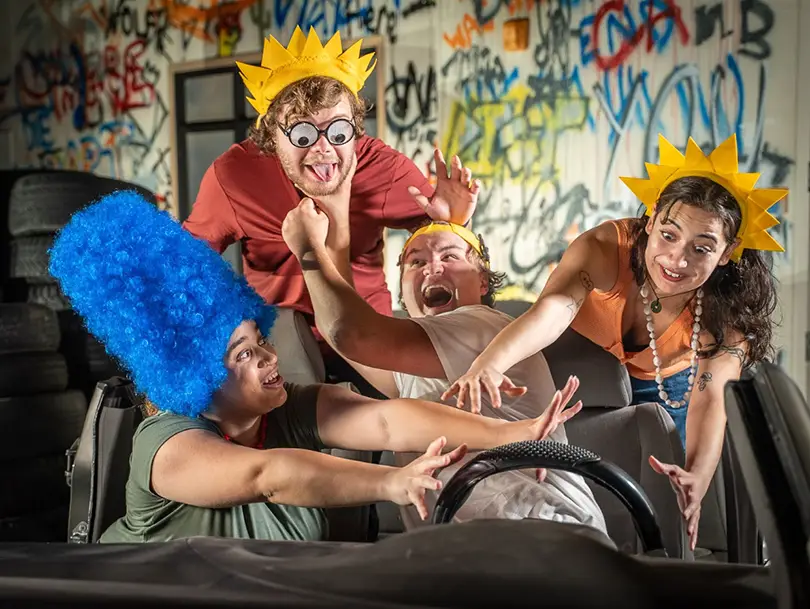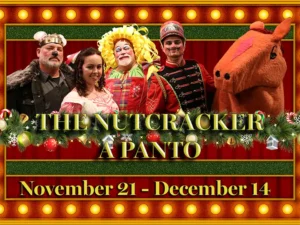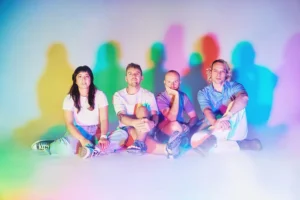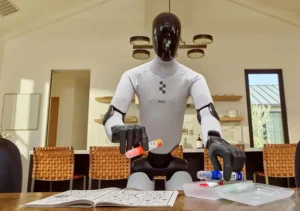Walking in a loose line of attendees, snaking around the back of the Harris Center for the Arts on our way to the first of the three stages where we’d see Falcon’s Eye Theatre’s production of “Mr. Burns: A Post-Electric Play,” my expectations were set higher than I normally would have them.

When heading out to review a show, I try my best to stay open-minded; I approach my reviews as an opportunity to positively, but honestly, celebrate the people in the greater Sacramento area who take on the laudable work of putting on plays. But this show was different. I had worked with some of the cast and many of the crew before, and knew how high a bar they were capable of hitting. Paired with that, they were taking on one of my favorite plays penned in the past 20 years — I’d fallen in love with the story and its impeccably well-layered references and themes after seeing Sacramento City College’s staging of it in 2021.
I have been lucky enough, in the course of reviewing local theater, to see an unbroken string of fantastic shows this year; please understand me when I say that this show takes the cake (or perhaps the pink-frosted sprinkled donut, in this case). My expectations were so summarily exceeded that I am left with no question in my mind: “Mr. Burns” is my pick for the best play I’ve seen in 2025.
For the uninitiated, without giving away too many spoilers, the show explores days and years after an unclear but hinted-to event kills the electrical grid as we know it. As people struggle to survive, they return to humanity’s roots, telling stories around the fire — and the stories, at first just attempts to recall episodes of “The Simpsons,” evolve over time. The play is an exploration of storytelling, theater, mythologizing, nuclear energy and how stories can carry the past forward.
The production is a sterling example of what magic can be achieved when all the aspects of theater are firing on all cylinders.
The sets are truly incredible; by adopting a promenade-style staging of the play, the creative team was given the freedom to go wild with each act’s set, and each one is more impressive than the last. The sets are immersive experiences, with the audience sitting around a dim campfire in an unfinished room soon after the apocalypse, then moving on to a time-worn and graffiti-stained auto shop serving as a rehearsal space. The third act ditches the apocalyptic grit for a vintage-inspired stage — complete with Vaudeville noise-makers and a live band — that I’ve yet to stop thinking about.
The costuming also shows a fine eye for detail. Clothes show wear over time, with more patches and road-worn looks in the change from Act 1 to 2. The begrimed chorus robes in Act 3, along with the beautifully designed masks (particularly Groundskeeper Willie, Mr. Burns and Nelson Muntz), appear so perfectly suited for the moment that it lends to the transportative experience the show’s unique presentation evokes.
Though some of the performances can come across as less polished (no surprise, given that this is a college production and some of the cast are fresh to the stage), there’s more than enough talent to keep audiences engaged the whole way through. Ry Silva’s Bart and Nicolas East’s Mr. Burns deserve particular praise as they carry the show home to its finale fantastically.
“Mr. Burns: A Post-Electric Play” runs through Sunday, Nov. 23 at the Harris Center for the Arts at Folsom Lake College, 10 College Parkway, with multiple showtimes Thursday through Sunday. Seat space is limited, so I suggest you snatch up a ticket while you can. Tickets are available here.
This story is part of the Solving Sacramento journalism collaborative. This story was funded by the City of Sacramento’s Arts and Creative Economy Journalism Grant to Solving Sacramento. Following our journalism code of ethics, the city had no editorial influence over this story. Our partners include California Groundbreakers, Capital Public Radio, Hmong Daily News, Outword, Russian America Media, Sacramento Business Journal, Sacramento News & Review and Sacramento Observer. Sign up for our “Sac Art Pulse” newsletter here.
By Odin Rasco














